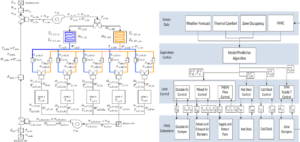Control dampers, also sometimes referred to as airflow dampers, are essential components within an HVAC system responsible for managing the direction and volume of airflow throughout the ductwork. They function like valves, opening and closing or adjusting to various degrees to achieve optimal climate control.
Here’s a breakdown of control dampers applications in HVAC systems:
Zone control:
In buildings with multiple zones or rooms requiring different temperatures, control dampers allow you to direct conditioned air to specific areas. This is particularly useful in homes with zoning systems where you might want cooler air directed more towards bedrooms and less towards the kitchen while cooking.

Mixing hot and cold air:
HVAC systems often combine hot and cold air streams to achieve a desired temperature. Control dampers play a crucial role in regulating the ratio of hot and cold air being mixed, ensuring comfortable temperatures throughout the building.

Maintaining comfort:
By precisely controlling airflow, control dampers help create consistent temperatures in different rooms. This avoids situations where some rooms become uncomfortably hot or cold.
Optimizing airflow:
Control dampers can prevent excessive air from reaching unused spaces, like storage closets or hallways. This ensures efficient airflow and reduces energy consumption by the HVAC system.
Looking to install a commercial HVAC System or Duct work in your Business Area?
Contact Vipul Ac to learn about our HVAC Service
Call +91 8000092000 Today.

Pingback: How do control dampers work? - Vipul AC